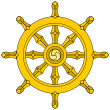Buddhisme di Nepal
artikel daftar Wikimedia
| Bagian dari seri tentang |
| Buddhisme |
|---|
 |
Buddha lahir di Kerajaan Sakya Kapilavastu yang terletak di distrik Rupandehi, kawasan Lumbini Nepal.[1][2] Belum memungkinkan untuk menetapkan dengan pasti tahun di mana Pangeran Siddhartha (nama kelahiran Buddha) lahir, biasanya disebutkan di sekitar 623 SM.[3]
Sebanyak 10,74% dari penduduk Nepal mempraktikkan Buddhisme, terutama terdiri dari etnis berbahasa Tibeto-Burma.[4] Di wilayah perbukitan dan pegunungan Nepal, agama Hindu telah menyerap ajaran Buddha sedemikian rupa sehingga dalam banyak hal mereka telah berbagi dewa-dewi serta kuil. Sebagai contoh, kuil Muktinath adalah sebuah tempat peribadatan umum dan suci bagi umat Hindu dan Buddha.[5]
Referensi
- ^ Smith, Vincent A. (1914). The Early History of India from 600 B.C. to the Muhammadan Conquest Including the Invasion of Alexander the Great (edisi ke-3rd). London: Oxford University Press. hlm. 168–169.
- ^ UNESCO (2012). "Lumbini, the Birthplace of the Lord Buddha". UNESCO: World Heritage Centre.
- ^ Thomas, Edward Joseph (1927 (AES Reprint: 2000)). "The Birth of Buddha". The Life of Buddha as Legend and History. New Delhi: Asian Educational Services (AES). hlm. 27–37. ISBN 81-206-0979-4.
- ^ Dahal, Dilli Ram (2003). "Social Composition of the Population: Caste/Ethnicity and Religion in Nepal" (PDF). Population Monograph of Nepal 2003. Central Bureau of Statistics (CBS), Government of Nepal. 1: 104–106. Diarsipkan dari versi asli (PDF) tanggal January 7, 2014.
- ^ Shastri, G. C (July 1968). "Hinduism and Buddhism in Nepal" (PDF). Ancient Nepal: Journal of the Department of Archaeology. 4: 48–51. Diarsipkan dari versi asli (PDF) tanggal July 6, 2012.